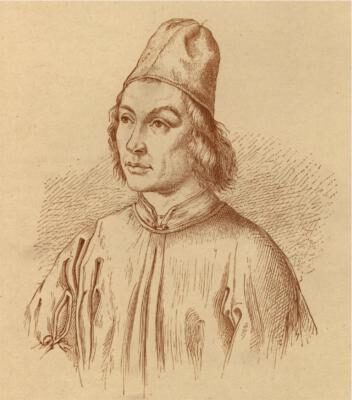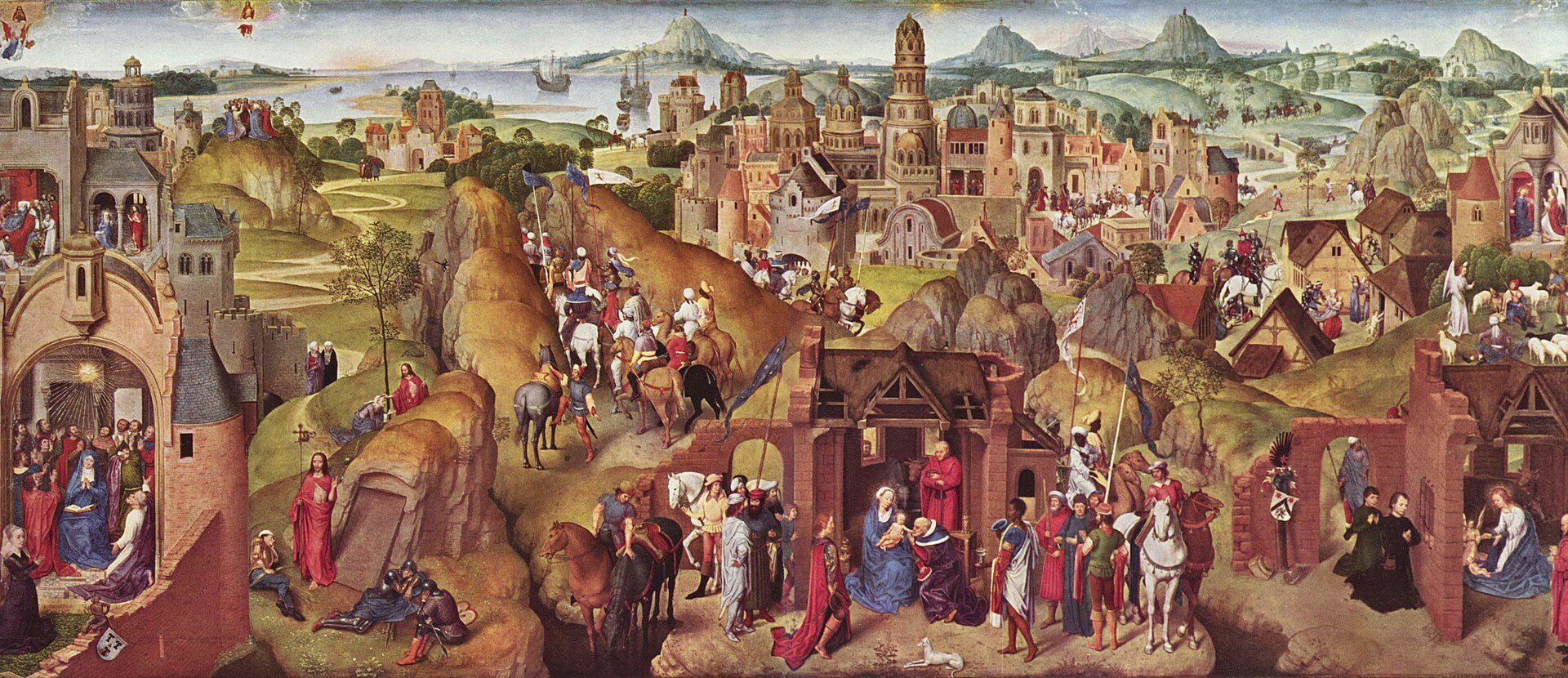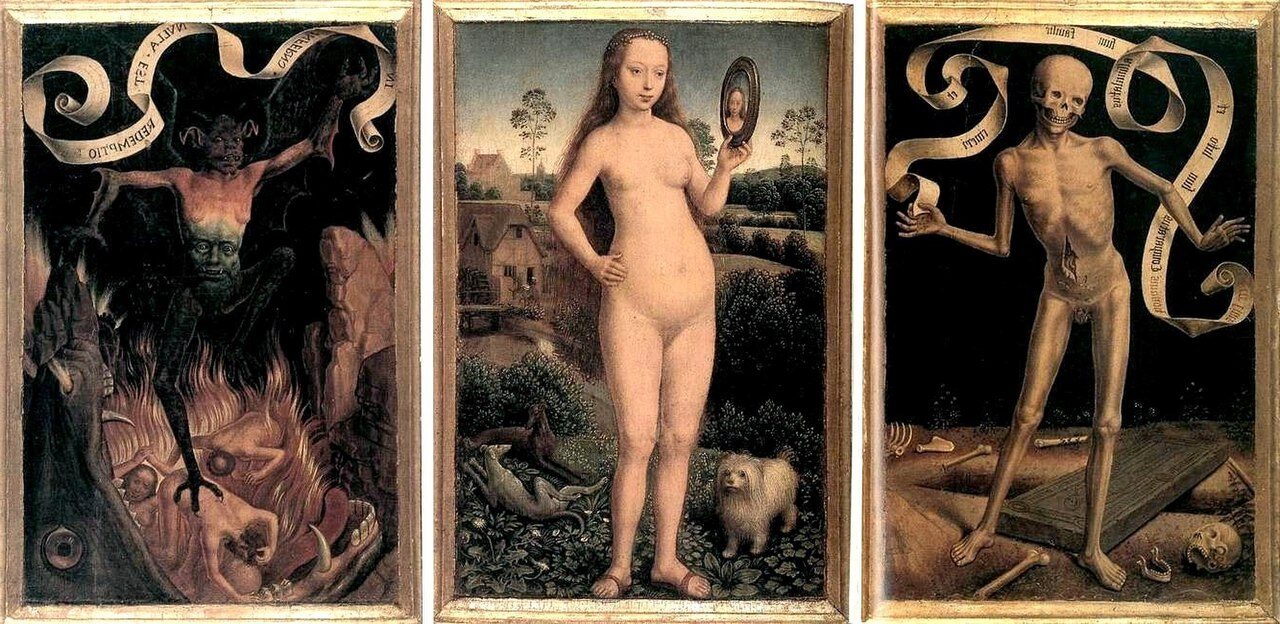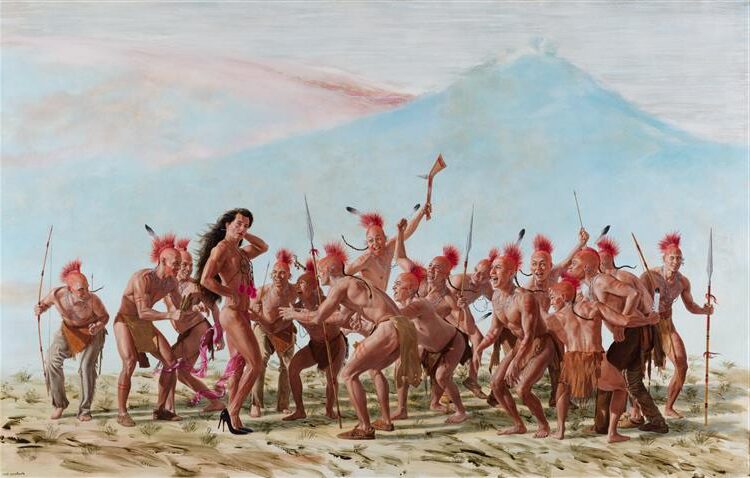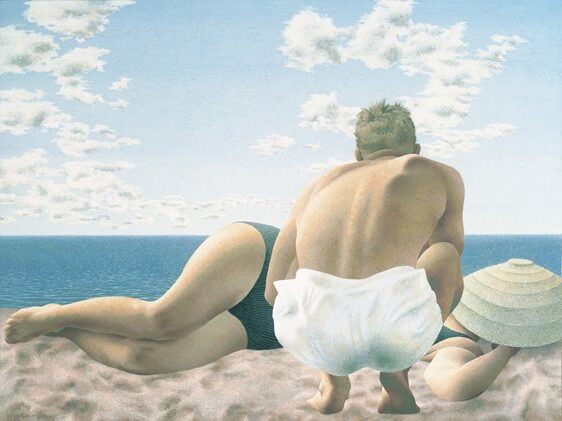Hans Memling, Painter: The Renaissance Master of Flemish Art
Born: c. 1430, Seligenstadt, Electorate of Mainz, Holy Roman Empire
Death: 11 August 1494, Bruges, County of Flanders, Kingdom of France
Mouvement artistique : Renaissance du Nord
Nationality: German-Flemish
Institution: Workshop of Rogier van der Weyden
Hans Memling, Painter: The Renaissance Master of Flemish Art
Life and Career of Hans Memling
Hans Memling emerged as one of the most significant Flemish painters of the 15th century. He developed his distinctive style during Bruges’ commercial golden age. His career spanned approximately thirty years. During this time, he created around 90 surviving paintings for an international clientele.
Début de la vie et influences
Hans Memling was likely born in the early 1430s in Seligenstadt, Electorate of Mainz, Holy Roman Empire. While details of his youth remain scarce, evidence suggests he received his initial artistic training in Cologne.

Earthly Vanity and Divine Salvation (triptych, front) (c. 1485) by Hans Memling
Memling later moved to the Netherlands, where he studied under Rogier van der Weyden in Brussels. This apprenticeship proved crucial to his artistic development. Van der Weyden’s influence appears clearly in Memling’s early works, particularly in his religious compositions and portraiture techniques.
The young artist absorbed not only van der Weyden’s technical approaches but also elements from Jan van Eyck‘s precise style. This combination of influences helped Memling develop his own distinctive artistic voice that balanced technical precision with emotional restraint.
Memling in Bruges
By 1465, Memling had established himself in Bruges, which was then a thriving commercial center despite beginning to experience political decline. He became a citizen of Bruges in 1467 and set up a successful workshop in the city.
Memling quickly developed a reputation among wealthy merchants, aristocrats, and church officials. His international clientele included patrons from England, Germany, and Italy, demonstrating his widespread appeal.
Unlike some contemporaries, Memling’s work focused on clarity and accessibility rather than innovation. His paintings featured serene compositions with balanced color schemes. This approach proved commercially successful, making him one of the wealthiest painters in Bruges.
He received numerous commissions for altarpieces, devotional panels, and portraits. The “St. John Altarpiece” and “Donne Triptych” showcase his meticulous attention to detail.
Contemporains notables
Memling worked during a transformative period in Flemish art. While he developed his own distinctive style, he operated within a rich community of talented artists.

Scenes from the Passion of Christ (c. 1470) by Hans Memling
His predecessors, particularly Jan van Eyck and Rogier van der Weyden, established the Flemish style’s foundations. Memling built upon their innovations while working alongside contemporaries like Hugo van der Goes and Petrus Christus.
Unlike some of his more emotionally expressive contemporaries, Memling maintained a more balanced approach. His work typically featured graceful figures in harmonious compositions without the intense drama seen in other Flemish painters’ works.
Memling’s relationships with other Bruges artists remain somewhat unclear, though he clearly operated within the city’s guild system. His workshop produced many works, suggesting he employed assistants who helped fulfill his numerous commissions.
Style artistique et contributions
Hans Memling developed a distinctive artistic approach that combined meticulous detail with balanced compositions. His work shows remarkable technical skill in depicting reflective surfaces and creating coherent three-dimensional spaces.
Evolution of Painting Style
Memling worked in the tradition of Early Netherlandish painting, adopting techniques from predecessors while developing his own refined style. He created highly detailed, illusionistic works characterized by their careful balance and harmonious compositions.

Christ Surrounded by Musician Angels (c. 1480) by Hans Memling
His paintings display exceptional technical precision, particularly in rendering textures and light effects. Memling excelled at depicting reflective surfaces with remarkable accuracy.
The artist’s approach to the human figure was notably sculptural, giving his subjects a three-dimensional presence. This technique helped his figures appear more lifelike and dimensional within the picture plane.
Over time, Memling developed a softer painting style that emphasized gentle transitions and harmonious color relationships. His works typically feature clear, luminous colors and careful modeling.
Triptychs and Altarpieces
Memling created numerous religious triptychs and altarpieces that showcase his narrative skills. These multi-paneled works often depict biblical scenes with remarkable attention to detail.
His Adoration of the Magi appears in several important altarpieces, demonstrating his ability to arrange multiple figures in coherent spatial relationships. In these works, he balances complex compositions with clarity and precision.
Memling’s treatment of the Virgin and Child theme shows his sensitivity to emotional expression. He typically portrays the Madonna with a serene, contemplative expression that conveys both dignity and tenderness.
His altarpieces often include the Man of Sorrows, depicted with restrained emotion that emphasizes spiritual contemplation rather than physical suffering. This approach reflects Memling’s preference for quiet devotion over dramatic intensity.
Portrait
Memling made significant contributions to the development of Renaissance portraiture. His portraits combine psychological insight with technical precision, capturing both physical likeness and personality.

Seven Joys of the Virgin (1480) by Hans Memling
One of his most innovative contributions was the use of landscape backgrounds in portraits. This technique, pioneered by Memling, influenced subsequent generations of portraitists and expanded the expressive possibilities of the genre.
His portraits typically show subjects in three-quarter view against simple backgrounds. This approach allows for both detailed facial rendering and a sense of three-dimensional presence.
Memling’s portrait subjects generally display a calm, dignified demeanor. He captures subtle expressions that suggest inner thoughts without overstating emotional states.
As a citizen of Bruges, Memling painted numerous portraits of wealthy merchants and civic leaders. These works combine careful observation with a respectful approach to individual character.
Héritage et influence
Hans Memling’s artistic contributions extended far beyond his lifetime, shaping portraiture techniques and religious painting for generations. His meticulous attention to detail and innovative compositional approaches continue to influence art history and practice.
Preservation of Memling’s Works
Many of Memling’s paintings have survived the centuries remarkably well, allowing modern viewers to appreciate his mastery. The Memling Museum in Bruges, housed in the medieval Hospital of St. John, contains his most significant works, including the famous St. Ursula Shrine and “The Mystic Marriage of St. Catherine.”
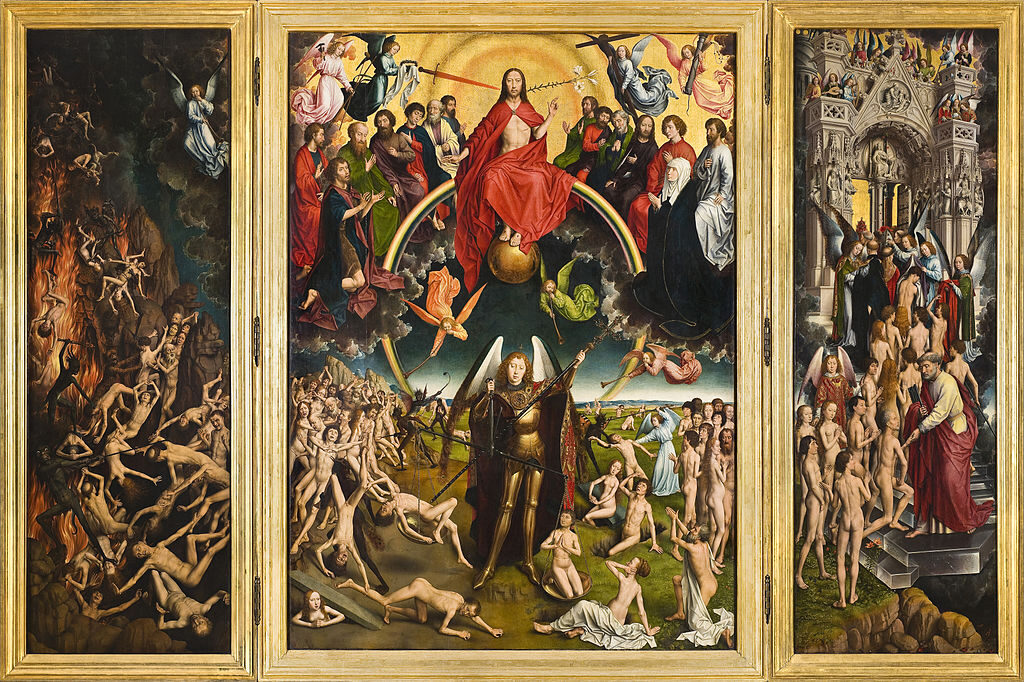
Last Judgement (1466–1473) by Hans Memling
Several major museums worldwide hold important Memling pieces. His altarpieces, including “The Last Judgment” in Gdańsk, Poland, demonstrate his skill in creating complex religious narratives with exceptional technical precision.
Conservation efforts have revealed Memling’s working methods through infrared reflectography and x-ray analysis, showing his careful planning and execution processes.
Impact sur les artistes ultérieurs
Memling’s influence spread throughout Europe during the Renaissance and beyond. His portrait style, characterized by calm figures posed against landscape backgrounds, became a model for later painters across the continent.
Northern European artists particularly adopted his techniques for depicting saints with individualized features and serene expressions. Memling’s approach to religious subjects struck a balance between devotional purpose and artistic beauty.
His innovations in diptychs for personal devotion influenced both composition and subject matter in religious art. Artists like Albrecht Dürer and later Flemish painters drew inspiration from his precise technique and emotional restraint.
Memling’s Role in Art History
Memling occupies a crucial position in the development of Renaissance nordique art. As the leading painter in Bruges during its commercial decline, he maintained l'excellence artistique while adapting to changing patron demands.
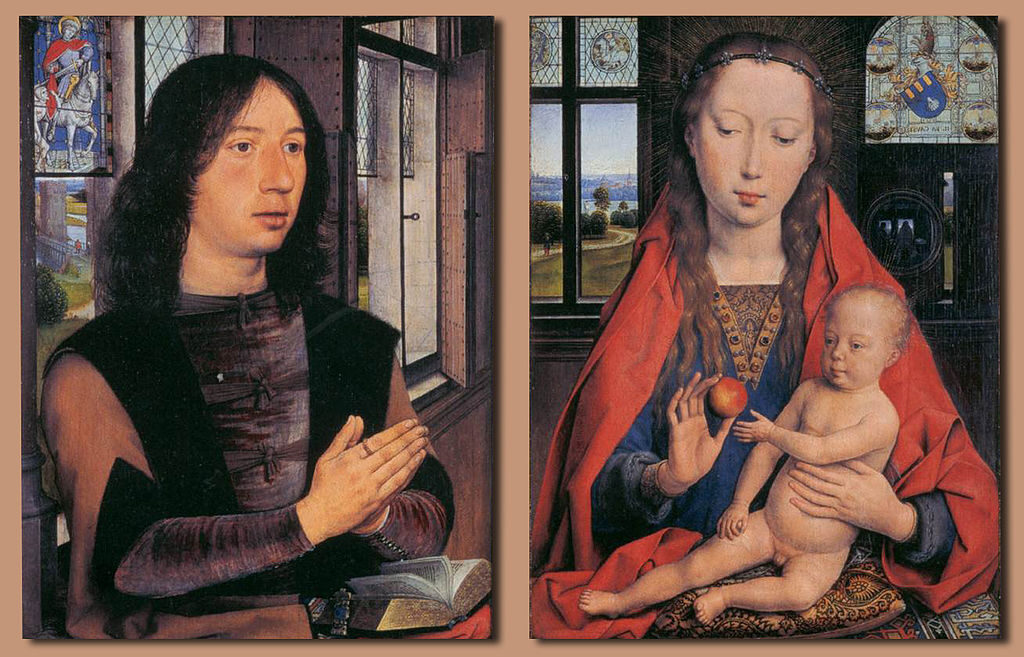
Diptych of Maarten van Nieuwenhove (1487)
Art historians recognize Memling as a pivotal figure who refined techniques pioneered by Jan van Eyck and Rogier van der Weyden. His work represents the height of Flemish painting’s technical sophistication before stylistic changes of the 16th century.
Memling’s paintings serve as important historical documents, recording the appearance of prominent merchants, clergy, and nobility of his time. His religious compositions offer insights into late medieval devotional practices and theological understanding.
Questions fréquemment posées
Hans Memling’s artistic legacy raises many questions about his techniques, influence, and notable works. The following addresses key aspects of his painting style, contributions to Renaissance art, and analysis of his most significant pieces.
What are the defining characteristics of Hans Memling’s artistic style?
Hans Memling’s style featured exceptional attention to detail, particularly in portraiture. He created smooth, polished surfaces and used soft lighting that gave his subjects a gentle, serene quality.
Memling often employed symmetrical compositions and precise spatial arrangements. His figures typically display calm expressions and dignified poses.
His work combined the meticulous detail of earlier Flemish painters with a more harmonious and less rigid approach. Memling was known for rich colors and the careful rendering of textures, especially in fabrics and jewelry.
What influence did Hans Memling have on the development of Northern Renaissance art?
As the leading artist in Bruges during its commercial decline, Memling helped preserve and evolve the Netherlandish painting tradition. He refined the portrait styles developed by earlier masters and made them more accessible.
Memling’s work became a bridge between early Flemish painting and later Renaissance developments. His influence spread through his many pupils and through merchants who commissioned his work and took it to different parts of Europe.
Many later Flemish and German painters adopted elements of Memling’s compositional techniques and his approach to portraiture. His balanced, harmonious style helped shape the direction of Northern Renaissance art in the late 15th century.
Which works of Hans Memling are on display at the National Gallery?
The National Gallery houses several important Memling works, including portrait panels that showcase his mastery of the form. His “Portrait of a Young Man” demonstrates his ability to capture lifelike features with subtle modeling.
The Gallery also displays religious works that highlight Memling’s skill with narrative scenes. These pieces showcase his distinctive approach to composition and his delicate handling of light.
Visitors can observe Memling’s technical precision in the detailed backgrounds and landscapes that often appear in his paintings, elements that became influential in later Northern Renaissance art.
How does Memling’s ‘Last Judgement’ reflect the artistic and cultural context of its time?
Memling’s ‘Last Judgement’ triptych captures the religious concerns and moral framework of 15th-century Europe. It vividly depicts the Christian belief in divine judgment, showing souls being sorted between heaven and hell.
The work reflects the Bruges school’s emphasis on detailed symbolic elements and religious storytelling. Memling includes numerous figures and scenes that would have resonated with viewers familiar with Christian doctrine.
The triptych also demonstrates the innovations artistiques of the period, with its complex composition, realistic figures, and atmospheric perspective. The painting combines religious devotion with the emerging humanistic focus on individual human experience.
Can you describe the iconography and significance of ‘The Annunciation’ by Hans Memling?
In ‘The Annunciation,’ Memling depicts the angel Gabriel informing Mary she will bear Christ. The painting employs traditional symbolic elements like the lily, representing Mary’s purity, and the dove symbolizing the Holy Spirit.
Memling places the scene in a detailed Flemish interior that would have been familiar to contemporary viewers. This domestication of a sacred event was characteristic of Northern Renaissance approaches to religious subjects.
The work shows Memling’s mastery of perspective and architectural space. His treatment of light filtering through windows creates a spiritual atmosphere while demonstrating his technical skill with optical effects.
What details in ‘Madonna and Child’ are emblematic of Hans Memling’s approach to portraiture?
In his ‘Madonna and Child’ paintings, Memling typically positions Mary and Jesus against backgrounds that enhance their significance. Sometimes, these are detailed landscapes or architectural settings that showcase his technical versatility.
The faces of mother and child display Memling’s characteristic gentle modeling and serene expressions. He captures a tender relationship while maintaining the religious dignity of the subjects.
Memling often includes symbolic objects like specific flowers, fruits, or books that carried meaning for 15th-century viewers. His attention to textures in clothing, hair, and skin demonstrates the technical precision that made his portraiture so highly valued.


